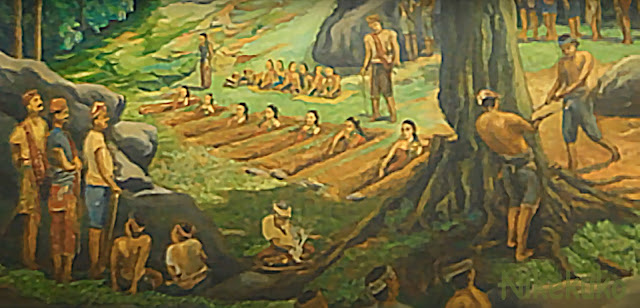The Origin Of Lebong "Benuang Sakti"
 |
"Benuang Sakti" |
Renah Sekalawi dulunya adalah kampung halaman suku Rejang. Di bawah kepemimpinan empat biksu, tanah itu kaya dan mulai berproduksi; pertanian telah dimulai di sana. Alhasil, budaya mereka semakin khas dan terkenal berkat tulisan mereka yang unik dalam aksara Ka-Ga-Nga (sampai sekarang masih dilestarikan dan diklaim sebagai tulisan asli suku Rejang).
The four monks' challenge came in the shape of a devastating disease outbreak that struck the community after they were chosen to lead the community organization. The catastrophe, a plague that killed many people of all ages and genders, happened toward the end of the XIII century. The calamity was brought on, in accordance with local astrologers' prophecies, by a white monkey by the name of Benuang Sakti who lived on a big tree in the middle of the forest.
The four monks decided to discover this large tree and quickly chop it down in the hopes that doing so would put a stop to the plague that had broken out in order to find a route out of the calamity. Following the division of labor, they dispersed across the forest until Biku Bermano's party eventually came and located the large tree they were seeking for. They promptly cut down the large tree, but their efforts were fruitless as it was being hacked down by axes, other trees.
The incident occurred after the party from Biku Sepanjang Jiwo arrived at the same location and attempted to cut the large tree, which was followed by the group from Biku Bejenggo, but the tree did not fall either. It grew bigger and bigger. The last group to arrive at that point was Biku Bembo, and they were told about a weird incident they had when they were felling a gigantic tree that refused to come down and even got bigger as a result.
"The words in the Rejang language, pio ba telebong, which signify that here you will gather, were spoken when the group led by Bikhu Bembo met up with the three groups at the location where a big tree was discovered, on which a white monkey named Benuang Sakti was located. Since that occurrence, Lebong has taken the place of Renah Sekalawi.
After hearing what had happened to the Bikhu Bembo group, they held a meeting to explore a solution and decided to consult Sang Hiang (the Almighty) for guidance on how to bring down the large tree. The method utilized by the four monks is using betarak (meditating), once the betarak has been done they receive instructions that the tree can be chopped down if it is sustained by seven young / adolescent ladies. Following that, they hurriedly prepared all of Sang Hiyang's instructions, including how they could prevent the seven girls from becoming victims or being trampled under a big tree that was about to be cut down. To save the seven girls, they dug a hole after that. The large tree was cut down once the ditch had been dug and the seven virgins had prepared to elevate the tree that would be removed....and the tree actually fell over the area where the seven daughters had gathered. The seven virgins were saved from death and were protected in the ditch that was built just where the huge tree had been cut down.
The aforementioned incidence served as the catalyst for naming their initiators in accordance with the efforts of each group of leaders to bring down a sizable tree under which the Benuang Sakti white monkey sits.
The Rejang term "berubeui-ubeui," which meaning in groups, is where the name Tubeui or Tubai of the Bikhu Sepanjang Jiwo comes from.
The word "Bermani," which derives from the Rejang language and means "tapai manis," is the name of Bikhu Bermano's petulai.
The name Jurukalang, which comes from the Rejang word "kalang" for galang, was given to Bikhu Bembo's petulai.
Selupuei, the Rejang term for heaped up, is how Petulai Bikhu Bejenggo got his name.
Renah Sekalawi was subsequently renamed Lebong, and the Rejang Empat Petulai was developed, serving as the foundation and genesis of the Rejang tribe.
Best wishes, and perhaps helpful (quoted from various sources) that's all, and many thanks.
